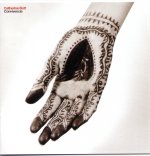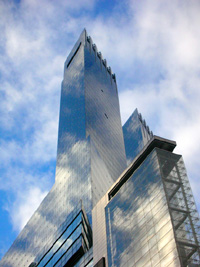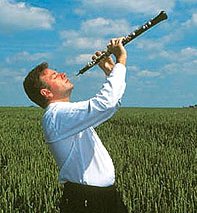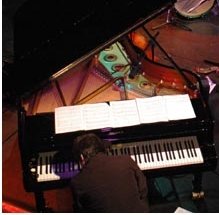When BMOP (the Boston Modern Orchestra Project), now in its 10th season, says “Project,” that’s exactly what they mean. Everything on their recent (Nov. 3) Jordan Hall concert — some six works by four composers — was slated for commercial recording immediately afterward. This done, the BMOP discography will have rolled up an impressive 20 releases.
They’re strong on the “Orchestra” part too. One reward (or even danger) in a program like this one, where everything was so “for” such an ensemble — BMOP’s personnel positively drips with class — — is that a listener could sit back mindlessly, pull the shades on his mean-spirited analytical tendencies and just let all those instrumental timbres, massed or individual, thrice-familiar or newly minted, wash over him. It was a rough evening for ascetics.
First came was “High Bridge Prelude” (1999), an autonomous instruments-only spinoff from his imposing soloists/chorus/orchestra cycle on texts of Hart Crane, which showed the veteran Charles Fussell hardly ever putting a foot wrong. Surely there was some sort of narrative in there? Correct — the sad short course of the poet’s life, as it turned out. The ear sensed this partly from the sure, canny pacing, but even more so from this composer’s un-ironic working of a tonal idiom that would once have been dismissed as “Hollywoodish.” Instances: the troubling, grayish wind chords over darkly suggestive unison low strings; the mean stalking pizzicato bass line doubled by timpani; and the art of the long-building glowery climax. The overall impression was of a noirish texture (velvety black to gritty pale) on the move, judiciously reined in by a sense of beginning, middle, and end.
About Fussell’s curtain-raiser you knew for sure that it wasn’t going to go on forever or anywhere close to it. Which was not the case at all with Derek Bermel‘s exuberantly sprawling, ethnologically informed, labile, damn-it-all-I’ve-got-the-microphone “Thracian Echoes” piece (2002), the kind of dazzler that in a different age (say, Leopold Stokowski’s lifetime) might have borne a hokey title like “Bulgarian Rhapsody.”
But back then Bermel wouldn’t have gotten away with it. Would symphonic musicians then have been nearly as confident at “bending” notes as BMOP’s wind players were, or for that matter improvising, or barging their way through fierce metrical thickets, or playing out of phase, or abandoning themselves to an esthetic that knows what it is to go much too far and goes right ahead anyway?
“Thracian Echoes” is an exciting piece by a composer with what seems to be — on this single scrap of evidence — an extraordinary ear for translating his ethnological adventures into orchestral music that is itself adventurous and, in the doing, making it quite personal as well. Who else could have made all that up? “Thracian Echoes” was the hit of the concert.
The Fussell and Bermel pieces were sited on opposite ends of a very well-filled program. In between (and frankly threatening to fade from the memory) came a pair by BMOP’s new Composer in Residence Lisa Bielawa — “Unfinish’d, Sent” (2002) and “Roam” (2001) — in which an undoubted love for high-class literary texts sat uneasily at times with a magpie, somewhat naive composing persona. This showed a talent in the making, if nerviness and ambition have anything to do with it. Bielawa’s c.v. mentions Philip Glass, Brian Ferneyhough, Yale, and cabaret. “Keep tuned,” it all seemed to say.
The recurrent problem with the late Establishment heavy Jacob Druckman‘s music — as it was here, with his “Nor Spell Nor Charm” (1999) and “Quickening Pulse” (1988) — was that you couldn’t always be sure that the exquisitely wafting timbres weren’t the be-all and end-all. Or is it that the music isn’t as performance-proof as it has seemed?
As to that and the rest, no doubt time — and the forthcoming BMOP recordings — will tell. All throughout, the orchestral playing under Gil Rose‘s direction, unshowy but energizing, seemed to be speaking volumes. It inspired trust.
RICHARD BUELL may be reached at rbuell@verizon.net
 The
The  How about a nice round of applause for Jeff Harrington who blogged all three nights of the Keys to the Future Festival. Bravo, well-done and many thanks for giving me an excuse to focus on more lucrative (hopefully) projects this week and to gloat over certain current events. I refer, of course, to the beginning of the return to sanity of American government and the exciting Rutgers victory over Louisville. When West Virginia knocks off Rutgers on December 2, revenge will be complete.
How about a nice round of applause for Jeff Harrington who blogged all three nights of the Keys to the Future Festival. Bravo, well-done and many thanks for giving me an excuse to focus on more lucrative (hopefully) projects this week and to gloat over certain current events. I refer, of course, to the beginning of the return to sanity of American government and the exciting Rutgers victory over Louisville. When West Virginia knocks off Rutgers on December 2, revenge will be complete.  THE WEATHER RIOTS
THE WEATHER RIOTS This past Sunday 37,936 people ran 26.22 miles through parts of all five boroughs of New York City from Staten Island to Central Park, through parts of all five boroughs. The marathon has taken place on the first Sunday of November every year since 1970, and this year Jelena Prokopcuka won the women’s division with a time of 2:25:05, M. Gomes dos Santos won the men’s division clocking in at 2:09:58, and the wheelchair divisions male and female winners were Stephen Kiogora (2:10:06) and Paul Tergat (2:10:10).
This past Sunday 37,936 people ran 26.22 miles through parts of all five boroughs of New York City from Staten Island to Central Park, through parts of all five boroughs. The marathon has taken place on the first Sunday of November every year since 1970, and this year Jelena Prokopcuka won the women’s division with a time of 2:25:05, M. Gomes dos Santos won the men’s division clocking in at 2:09:58, and the wheelchair divisions male and female winners were Stephen Kiogora (2:10:06) and Paul Tergat (2:10:10). Tomorrow (Nov 6) soloist Nicholas Daniel (left) and the Britten Sinfonia give
Tomorrow (Nov 6) soloist Nicholas Daniel (left) and the Britten Sinfonia give  You don’t need to be a
You don’t need to be a 